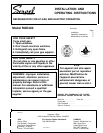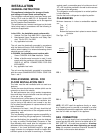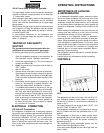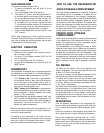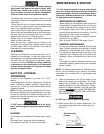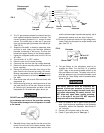
GAS OPERATION
The position numbers refers to FIG. 3.
1.
2.
3.
4.
5.
To start the refrigerator, turn the knob “A” to the
“GAS” position.
Turn the thermostat knob
"B"
to setting 4.
Push button
"C"
to stop
-
and hold, push button
“D”
for the piezo igniter several times to light the burner.
This can be observed through the flame view port
“E”.
After the flame lights, continue to hold the button
“C”
for an additional ten (10) seconds. Release the button
“C”
and check the flame view port
“E”
to make sure
the burner does not go out. If the burner goes out,
repeat the lighting procedure Steps 1 through 4.
To shut off the refrigerator, turn the knob “A” to the
“OFF” position.
NOTE: After changing an LP tank, or after a long shut
off period, the gas line is likely to be filled with air. You
may have to repeat the lighting procedure several times
to purge the air out of the gas lines.
ELECTRIC OPERATION
The position numbers refers to FIG. 3.
1.
Check to be sure the power cord is properly connect-
ed to the power supply.
2.
Turn knob “A” to the position marked “ELEC” for 120
volt AC operation.
3.
Turn the thermostat knob
"B"
to setting 4.
4.
To shut off the refrigerator, turn the knob “A” to the
“OFF”
position.
THERMOSTAT
The refrigerator is equipped with a thermostat that can
be adjusted by turning knob
“B”
to different setting to
maintain the desired cabinet temperature. See FIG. 3.
1.
2.
3.
“OFF”
Setting of the
Thermostat: In gas operation,
the thermostat closes its main valve and the burner
runs continuously at the bypass rate or pilot. In
electric operation, the contacts in the thermostat are
open and the heating element is off.
“MAX” Setting of
the Thermostat:
In gas operation,
the thermostat allows the burner to remain on high
flame continuously. In electric operation, the heating
element is “ON” continuously.
The thermostat can be adjusted between “MAX” and
“OFF” to obtain the desired cabinet temperature. The
closer the knob is to “MAX”, the colder the cabinet
temperature. The closer the knob is to “OFF”, the
warmer the cabinet temperature.
When the thermostat reaches the set temperature, it will
cut the burner back to bypass or, in electric operation,
shut off the heating element.
The setting of the thermostat is not critical, but we
recommend it be adjusted to maintain a dry frost on the
cooling fins. Adjust the thermostat knob closer to “MAX”
when the outside temperature becomes warm.
HOW TO USE THE REFRIGERATOR
FOOD STORAGE COMPARTMENT
The food storage compartment is completely closed and
unventilated, which is necessary to maintain the re-
quired low temperature for food storage. Consequently,
foods having a strong odor or those that absorb odors
easily should be covered. Vegetables, salads etc. should
be covered to retain their crispness. The coldest posi-
tions in the refrigerator are under the cooling fins and at
the bottom of the refrigerator. The warmer areas are on
the upper door shelves. This should be considered when
placing different types of food in the refrigerator.
FROZEN FOOD STORAGE
COMPARTMENT
Quick frozen soft fruits and ice cream should be placed
in the coldest part of the compartment which is at the
bottom of the aluminum liner. Frozen vegetables, may be
stored in any part of the compartment.
This compartment is not designed for deep or quick
freezing of food. Meat or fish, whether raw or prepared,
can be stored in the frozen food storage compartment
provided they are precooled first in the refrigerator. They
can be stored about three times longer in the frozen food
compartment as compared to the fresh food compart-
ment. To prevent food from drying out, keep it in covered
dishes, containers, plastic bags or wrapped in aluminum
foil.
ICE MAKING
Ice cubes can be made in the ice tray placed in the
freezer compartment. The tray should be filled with water
to within
1/4"
(5 mm) from the top.
For faster ice making, the tray should be placed in direct
contact with the bottom of the freezer compartment.
To release the ice cubes, seize the tray with both hands
and twist the tray. Cubes not required should be replaced
in the tray. Refill the tray with water and replace the tray
in the freezer compartment.
Ice will be made more rapidly if the thermostat is set at
its highest position. It is a good idea to do this a few hours
before the anticipated need for ice, but be sure to turn
the thermostat back to normal setting, usually about
mid-setting when the ice is formed. Food in the lower
compartment may be frozen if the refrigerator is left on
“MAX” position.
DEFROSTING
Frost will gradually accumulate on the refrigerating sur-
faces. It must not be allowed to grow too thick as it acts
as an insulator and adversely affects refrigerator perfor-
mance.
Check the formation of frost regularly every week and
when it gets about 3 mm thick, defrost the refrigerator.
Shut off the refrigerator by turning knob “A” to “OFF”
position. Empty the refrigerator, leaving the cabinet and
freezer doors open. Defrosting time can be reduced by
filling the ice tray with hot water and placing it in the
freezer compartment.



